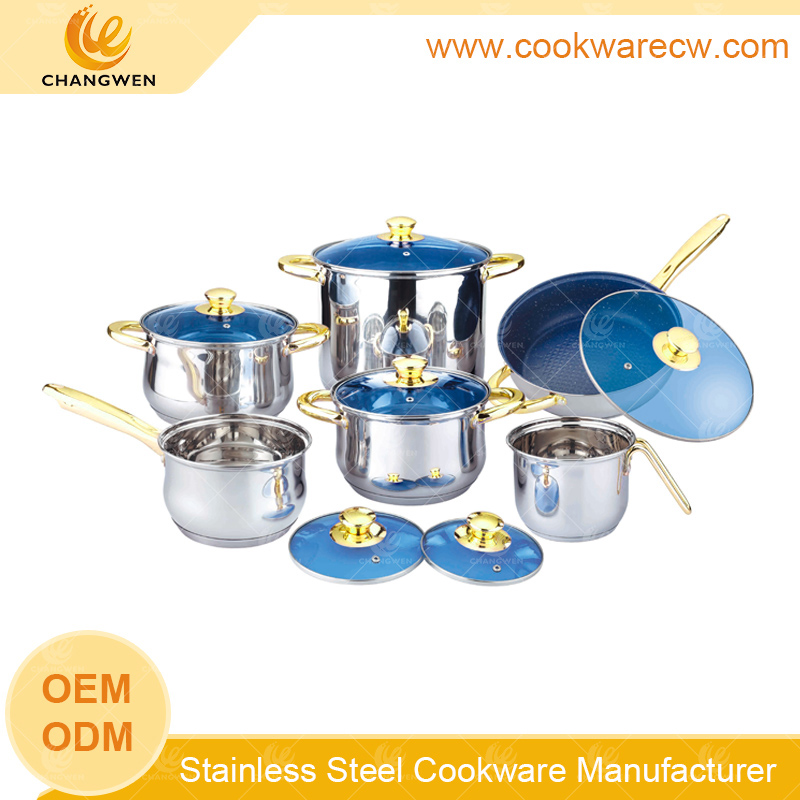Safest Stainless Steel Cookware
Changwen is a professional safest stainless steel sookware manufacturer and supplier. We can send quality stainless steel sookware to all parts of the world with our good customer relations and impeccable service. Changwen is a manufacturer that manufactures a variety of stainless steel sookware according to your requirements and also provides wholesale business. Please send us your ideal stainless steel sookware and we will be happy to provide you with the stainless steel sookware you need.
Tel: 86-13929001235 (WhatsApp)
E-mail: changwen@cwcooking.com
Safest Stainless Steel Cookware refers to cookware made of high-quality stainless steel materials, with excellent corrosion resistance, high temperature resistance, non-toxic and harmless, and easy to clean.
1. Features
Waterproof and heat-resistant: Stainless steel cookware is not afraid of water, nor will it deform due to high temperature. It has good anti-fouling and permeability, and can maintain brightness for a long time.
No radiation and formaldehyde: Stainless steel belongs to the metal category, which has no radiation and does not contain formaldehyde. It is healthy and environmentally friendly, and meets the modern people’s pursuit of green life.
Strong impact resistance: Stainless steel has high hardness and good impact resistance, which is safer to use and not easy to break.
Seamless welding: High-quality stainless steel cookware usually adopts seamless welding or one-piece casting process, which has strong integrity, will not crack, and is more durable.
Environmentally friendly and bacteria-free: Stainless steel does not need to be tested, is absolutely environmentally friendly, and will not breed bacteria, ensuring food safety.
Easy to clean: Stainless steel cookware is easy to clean. Even if it has been used for many years, it can be easily cleaned with a rag dipped in detergent without leaving any traces.
Beautiful and durable: Utensils made of stainless steel are beautiful and durable, with good performance, corrosion resistance, bright appearance, and give people a clean and hygienic feeling.
2. What are non-toxic cookware?
Non-toxic cookware refers to cookware that does not release harmful substances during use and is harmless to human health. The characteristics of non-toxic cookware include:
Material safety: Made of non-toxic and harmless materials, such as stainless steel, glass ceramics, etc.
High temperature resistance: Able to withstand high-temperature cooking without deformation or release of harmful substances.
Easy to clean: Easy to clean, no harmful substances will remain.
No radiation: No radiation harmful to the human body.
1. Key indicators of non-toxic cookware
| Test items | Safety standards |
|---|---|
| Heavy metal migration | Lead (Pb) ≤0.1mg/kg, cadmium (Cd) ≤0.01mg/kg (in compliance with GB 4806.9-2016) |
| Coating safety | PFOA (perfluorooctanoic acid) and PTFE (Teflon must be marked with “Free of PFOA”) are prohibited |
| Oxidation stability | Acid and alkali resistance test (pH 2-12 environment without corrosion) |
| High temperature stability | Using temperature ≤260℃ (PTFE coating) or ≤450℃ (ceramic coating) |
2. Hazards of common toxic substances
PFOA: A carcinogen used in traditional Teflon coating production, decomposes at high temperature to produce toxic gases.
PTFE: High temperature (>260℃) may release harmful gases, and the use temperature must be strictly limited.
Heavy metals: Lead, cadmium, etc. are easily accumulated through the food chain, damaging the nervous system and kidney function.
3. Core features of the safest stainless steel cookware
1. Material selection
316 medical grade stainless steel:
Contains molybdenum (Mo 2-3%), resistant to strong acid and alkali corrosion (such as lemon juice, vinegar, sea water).
Suitable for coastal areas or cooking high-salt and high-acid foods.
304 food grade stainless steel:
Contains 8-10.5% nickel, has strong corrosion resistance, high cost performance, and is suitable for daily family use.
430 ferritic stainless steel (auxiliary components):
Economical material, containing 16-18% chromium, but weak rust resistance, mostly used for pot lids and handles.
2. Coating-free design
Physical non-stick technology:
Achieve microporous structure through precision polishing (Ra≤0.1μm) to reduce food adhesion.
Suitable for cooking with low smoke point oils such as olive oil and butter.
Ceramic coating alternative:
Inorganic silicate-based coating, high temperature resistance (≤450℃), no chemical additives.
3. Design and process safety
Seamless welding: Laser welding technology eliminates gaps and prevents bacterial growth.
Full-cover handle: Insulation material (temperature resistance ≥ 230℃) is integrally formed with the pot body to avoid scalding.
Removable accessories: Steamer, filter, etc. support high-temperature steam sterilization.
4. Certification guarantee
International certification:
FDA (USA): Ensure that cookware meets food contact material standards.
LFGB (Germany): Strictly test heavy metals and chemical migration.
EU CE mark: mandatory safety certification.
Test report: Provide heavy metal and coating safety reports from third-party organizations such as SGS and Intertek.
IV. Manufacturing process and quality control
1. Raw material processing
Sheet selection:
316 stainless steel thickness ≥ 0.8mm (cookware), surface roughness Ra ≤ 0.4μm.
Provide material certificate (specify nickel, chromium, and molybdenum content).
Cleaning process:
Electrolytic degreasing → pickling (nitric acid concentration 5-10%) → high-pressure water washing (pure water pH 6-7).
2. Core production process
Cold forging:
High-pressure forging (pressure ≥ 500 tons) increases density and reduces porosity.
Applicable to high-end cookware (such as Japanese iron kettle).
Precision welding:
Argon arc welding (weld width ≤ 1mm) → laser polishing (Ra ≤ 0.2μm).
Surface treatment:
Physical polishing: mechanical grinding (mirror effect, Ra ≤ 0.1μm).
Passivation treatment: immersion in nitric acid solution to form a dense oxide film (Cr₂O₃ layer).
3. Quality control nodes
Weld inspection: X-ray flaw detection (in accordance with ASTM E94 standard).
Corrosion resistance test: Salt spray test ≥ 48 hours (ASTM B117 standard).
Coating safety: Migration heavy metal detection (lead, cadmium ≤ EU standard).
4. Environmental protection and safety process
Chromium-free passivation: Oxalic acid or fluorozirconate is used to replace traditional chromate treatment.
Clean energy: Electric furnace is used throughout the production process (to avoid coal-burning pollution).
Packaging materials: Degradable EPE pearl cotton + kraft paper, PVC plastic is prohibited.
V. Customized service process
1. Demand analysis and design support
Function customization:
Coating type (ceramic/uncoated).
Heating method (gas/induction cooker/oven compatible).
Appearance customization:
Surface treatment (brushing, mirror polishing, etching pattern).
Color scheme (brand color customization, support Pantone color number).
2. Design and proofing
Structural design:
Anti-scalding design of the handle (ergonomic).
Multifunctional accessories (detachable steamer, thermometer hole).
Proofing process:
Provide 3D drawings (STEP format).
Proofing cycle: 15-30 days (coating process accounts for 50% of the time).
3. Mass production and delivery
Mass production cycle: 30-60 days (first batch of orders).
Packaging requirements:
Inner layer: EPE pearl cotton shockproof.
Outer layer: carton + moisture-proof film (humidity ≤ RH 40%).
4. Cost control and intellectual property protection
Cost optimization:
Reduce mold opening costs: reuse existing molds (such as general pot types).
Scale procurement: centralized procurement of coating raw materials (cost reduction of 10-15%).
Intellectual property protection:
Sign a confidentiality agreement (NDA).
Apply for appearance patents (search for design uniqueness in advance).
Sixth, common problems and solutions
1. How to verify the safety of stainless steel cookware?
Testing method:
Acid immersion test (soak in pH 2 vinegar solution for 24 hours and observe the color change).
Heavy metal migration test (commissioned to SGS and other institutions for testing).
2. How to deal with coating shedding?
Reason: Incomplete pretreatment of the substrate or high temperature exceeds the coating tolerance limit.
Solution:
Optimize the cleaning process before spraying (ultrasonic cleaning + pure water rinsing).
Limit the maximum use temperature (PTFE coating ≤ 260℃).
3. What material is the best for the safest stainless steel pot?
The safest stainless steel pot is a pot made of 304 or 316L stainless steel. These two materials excel in food safety and durability.
Conclusion
The safest stainless steel cookware needs to be strictly controlled in terms of material, process, and certification to ensure that it is non-toxic, harmless and durable. For wholesalers and custom demanders, choosing compliant suppliers, clarifying technical standards, and controlling supply chain risks are the keys to success.
Changwen is your safest stainless steel sookware manufacturer. Manufacture various types of safest stainless steel sookware according to your project needs, customized according to different colors, sizes, functions, etc. We also provide wholesale with our existing inventory. Free samples to check quality.
Related products
-

Hotsale 12pcs stainless steel cooking sets soup stock pot kitchen ollas saucepan casserole and milkpot fry pan nonstick CW-M1209
-
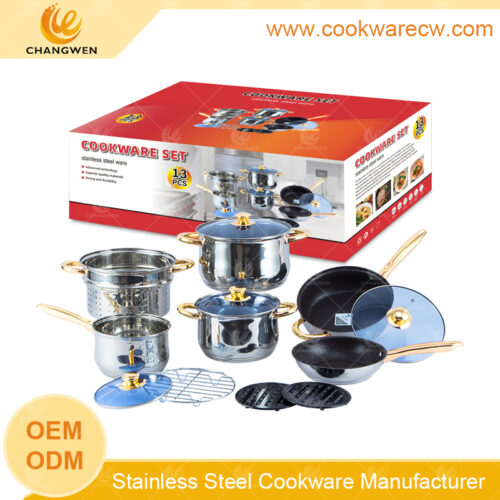
Factory Wholesaler 13 pcs nonstick stainless steel cookware set fry pan saucepan casserole steamer rack black mats CW-M1301
-
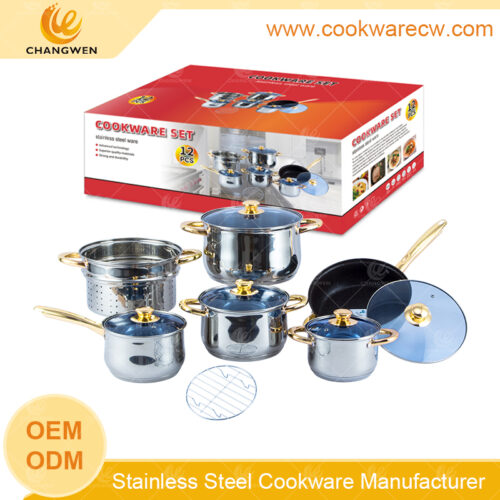
olla de cocina 12pcs cookware set non-stick coating frypan 24cm steamer pot with a stainless steel kitchenware wire rack CW-M1205
-
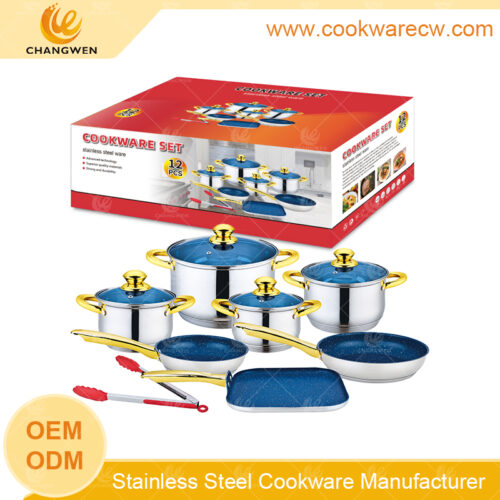
Hot sale SS ollas non-stick coated frying pans and pots stock pot with a kitchenware clip CW-M1204
-
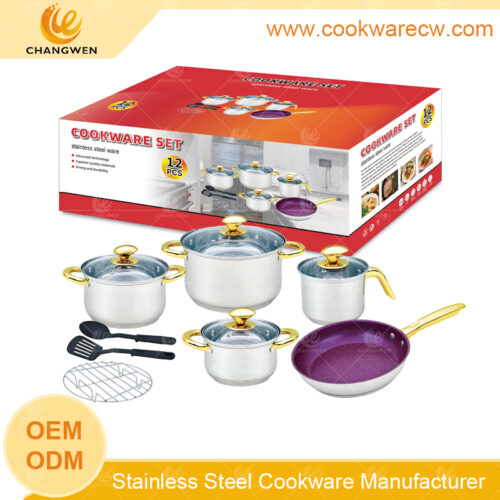
Cookware wholesaler 12pcs pots and pans stainless steel cooking sets kitchenware tools and steamer CW-M1211
-
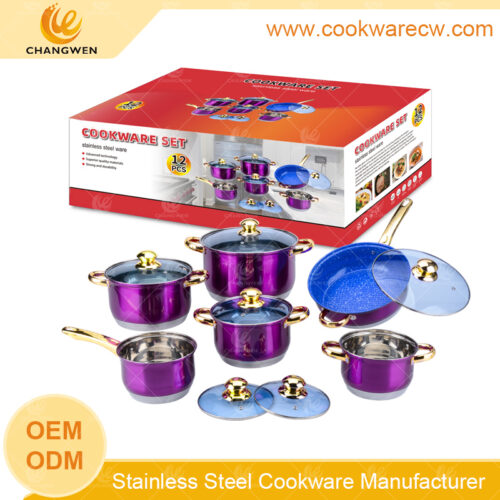
color coating surface stainless steel pots non-stick frypan golden S/S handles and knobs 430 protector for induction CW-M1225
-
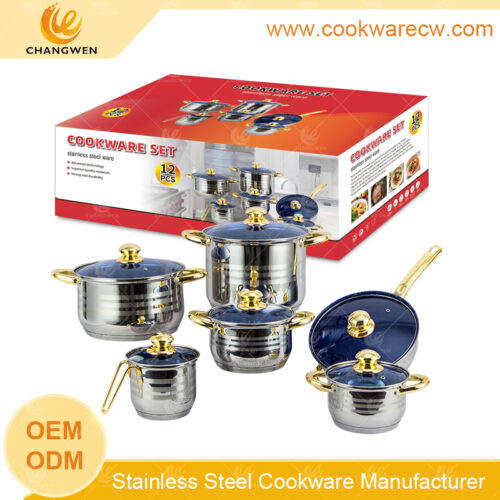
heavy S/S 12pcs cookware set pots wholesale nonstick fry pan blue glass lid golden handle cooking pan milk pot CW-M1222
-
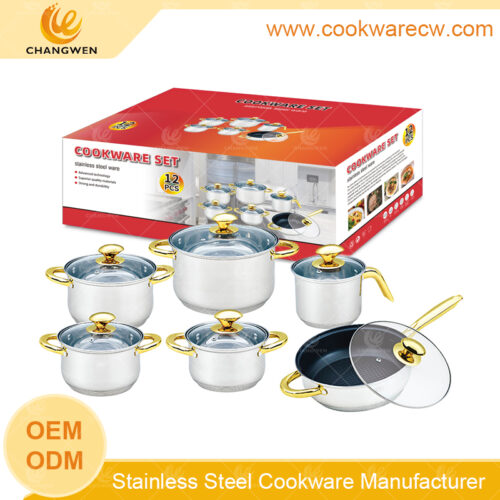
high quality stainless steel pots and pans 12pcs cookware set nonstick fry pans with 5-9 steps capsule bottom CW-M1212

